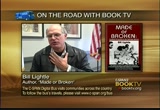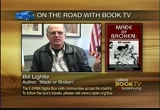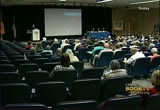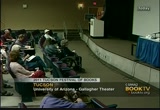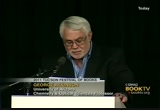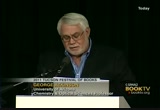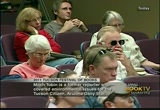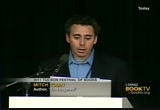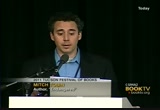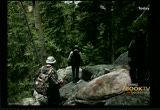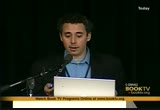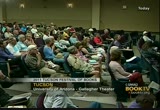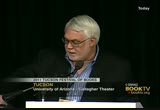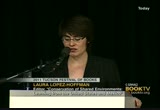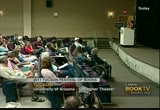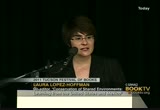tv 2011 Tucson Festival of the Book CSPAN March 13, 2011 1:30am-3:00am EDT
1:30 am
>> where you doing major broken? >> i relied on my own memory and get out before daylight, three practices a day, no water. the hazing, water moccasins, i was going through old stories and at this camp was built in the thirties and it did not close and there was one story and the ball is it. there is one story written by a sports writer talking about the upcoming season and half a great football teams come alive excitement and talk about the camp. and he uses that to phrase that the coach will take the kids out of the camp and they will be made or broken. ibr thought that was it.
1:31 am
. . about the first two. one is about a sharecropper, cotten picking boy at a mill worker and that's called "mill daddy, the life and times of roy davis." i wrote another called "a mother's dream." it was a dream about my father my mother had. it's about their love and baseball. it's more than that though. i have begun working on a book about grady caldwell and because of what happened to him, he fell into the pit of drug use and addiction. i interviewed him in prison, as a matter of fact for this book, but are other themes in his life, redemption, his family stuck with him, and now he's a
1:32 am
minister in georgia. i started work on this and interviews him this week, as a matter of fact. >> thank you so much for your time. >> thank you. >> we're back live from the gallager theater. starting shortly, a panel on climate change, hot times,. mitch tobin is author of "endangered". this is coverage of the 2011 tucson festival of books. >> good morning. welcome to the third annual tucson festival of books. i'm george at kinson, and i'm moderating this interesting session today called hot times:
1:33 am
can nature survive us? we like to begin by thanking the designed modelers for having this session, and i'd like to remind everybody that he with refortunate today to have this session broadcast live on c-span, so you're relatives are watching. the entire presentation and discussion including questions will last about approximately 1 hour. we'll begin with 10 minute summaries of their works by each of the authors, and in some cases, these summaries include brief powerpoint presentations. i'd like to ask the audience to please hold questions until all three authors finished. i'll provide brief introductions before each author begins their presentation. i'd also like to request that the audience consider presenting their questions very concisely.
1:34 am
primarily so we can preserve as much time as possible to listen to the authors' responses. perhaps in some cases we can follow-up with additional questions depending upon how this group is. we can meet the authors and have a more detailed discussion after the session, and when they proceed to the signing area where they sign their books. obviously, copies of the authors' books will be available for sale at that signing area. by way of introduction, i'd like to say that today there's three very distinguished and accomplished authors who've written excellent accounts concerning the most important environmental and ecological issues of our time. not only are these books highly authoritative and credible, but they, in my view, are accessible to the nonexpert, and in fact,
1:35 am
quite enjoyable to read. these issues, of course, transcend their technical descriptions which are often times the focus of many books including some of these. i think it's valid to anticipate that each of these issues addressed in the books by these authors will have significant and perhaps even profound everyone -- imp my cations for the decisions we all face, both immediately and over the long term. let's begin. we've chosen by collective decision to begin with mitch tobin whose book is entitled "endangered". mr. tobin had diverse experience with environmental issues. he's covered questions affecting the southwest and especially
1:36 am
arizona. he is the recipient of the john oaks award for distinguished environmental journalism. his work has been honored by a number of groups incoming best of the -- including best of the west competition with other authors, and by the arizona association press management editors. he continues his interest in environmental issues as a consultant and resides in denver, colorado. i was referring to your brother mark a moment ago. i apologize. it is, in fact, mitch tobin. mitch, i invite you to come to the podium. [applause] >> thank you, everybody. thanks so much for coming out on a beautiful day. it's great to be here in tucson, although i forgot summer begins in early march here. [laughter] i'll begin by giving you a quick
1:37 am
overview of the book and explain how climate change affects by yo diversity in general and specifically some species here in the southwest. i want to explain why my book focuses on the american southwest, and why i think it's a really critical area to look at in order to understand climate change and a number of other issues. i'm going to use one mountain as a microkosm, and that mountain is mt. gram, not too far from us here in tucson. one effect of climate change is the esklator effect where plants and animals move uphill as the temperature continues to rise and then talk about wild fires and the impact of our water supply. a big reason is i was a reporter here in tucson for almost eight years and was very frequently
1:38 am
covering endangered species issues, and that's because the endangered species agent is such a powerful and polarizing law. it turned out this was an important place to look at the issue of endangered species because we have so many in the southwest. i'm basically referring to arizona, new mexico, and the adjourning portions of colorado, utah, nevada, california, and i guess the west texas deserts. here in the southwest, we have a very large number of endangered species. this shows you county by county how many threatened species there are. there's a clear con concentration in the united states as well as florida and the appalachian mountains. the southwest has been one the fastest growing areas of the country and the population here has been increasing dramatically in all of the southwestern
1:39 am
states. we are leading the area with the population to be close to 11 million in 2030, and other states are growing as well, just not as fast. here in the southwest there's a an nexus with a diverse region and a variety of species and the most quickest growing regions of the country. that generated a lot of conflict over the endangered species act. why is a state like arizona so bilogically diverse? a lot of people who don't live here don't realize that because of the deserts. a lot has to do with elevation. this map shows you the state and the colors are shaded according to the elevation above sea level. over here in yuma in the southwestern state you're at sea level, and here in flagstaff, the san fransisco peaks and big
1:40 am
mountains, they are at 11,000 feet high. there's a big difference in elevation. you also see that with precipitation. this map shows you how much rain is expected to fall in an average year. over in the western deserts in yuma the average rainfall is 3 inches a year. here on mt. gram, it's over 36 inches a year, much of that falling as snow in the winter. a big difference in elevation and diverse climate. that translates into a very incredible array of ecosystems and has habitat. this is a simplification of the ecosystems we have in the southwest, and i've had to collapse a number of categories because there are so many of them in order to make it more legible. there's four deserts here.
1:41 am
in the higher eel visions which are shaded in green here, we have pine forests, and lower down is woodlands. because we have such a tremendous diversity of habitats, not surprisingly, there's the big diversity of species. the southwest is a hot spot for diversity. so this graphic shows you what a typical mountain in southern arizona right around here looks like, and on the mountains you see the diversity in habitat exceptionally well. here in tucson, of course, as you are familiar with, there's palaverdes. at the top there's spruce fir forests that represent southern canada even though you are close to the mexican border. on a single mountain range there's a tremendous variety of has habitats and therefore
1:42 am
species. this is one of the mountains, mountain gram, not to far from here, and i'm going to show you some of the different habitats. this at the base where there's prickly pears and agaves. this is about mid elevation, a white oak woodland, and these are spruce and fir trees along with aspen at the top of the mountain which is about 11,000 fetal. this is an overview and you probably have noticed this little box here, and those of you who have been around tucson for awhile, you are familiar with that. it's one the most powerful observatories in the world. it was put up that not without a huge fight, a lot happening here on campus with civil diso obedience and other stuff. there was a sub species of red
1:43 am
squirrel living on top of the mountain. the mountain squirrel is basically marooned on the top of this sky island. it's found nowhere else and it's been living there in isolation for 10,000 years or so. 10,000 years prior the earth's climate was different than it is today, and here in the southwest it was much cooler and wetter, and so you had spruce and fir forests at the bottom of the mountains, not just the tops. as the planet warmed up and emerged from the ice age, the trees and squirrels went to the top of the mountain. since then, the squirrel has been on top of the mountain and found nowhere else and evolved in isolation like many other species have. this is just a schematic to show you what the different types of layers of vegetation are like on the mountain. climate changes such a threat to species like the red squirrel
1:44 am
because this layer cake of life stones as i call them is not going to remain static if we continue to warm up the climate. today there's ponderosa pines between 8500 feet. if the planet warms up because of gas emissions, that layer is found between 85,000 and 10 -- 8500 and 10,000 feet. you can nix the spruce forests from the mountain. i don't think i've been on a mountain that's reverse. there's less surface area and habitat up there. as the layers are pushed up, it's troubling for the squirrel. this is a pica that some refer to as a boulder bunny. they are common in colorado where i live and on the top of mountains and sensitive to temperature. they can die if it's greater than 80 degrees, and that's why they live high in the boulder
1:45 am
fields in 13,000 and 14,000 foot mountains. on the left is where in orange where the pica is found today. on the right is what the projection is for 2100 what is suitable habitat. you can see it's a dramatic reduction in the range, and therefore it's potentially very, very dangerous for the species fate. just to sum up the global warming threat is, of course, involving warmer temperatures, but it also involves altered precipitation, and that's important in a place like the southwest. because of changes, we're seeing big shifts in vegetation and habitat because naturally they are in such close proximity. we're going to have a thinner snow pack because of warmer temperatures and higher evaporation rates, and higher
1:46 am
insect rates. that all leads to wild fires. wild fires are a natural part of the southwest, this was the beginning of the 2004 ned l fire on mt. gram and nearly took out the telescopes, but they were savedment the fire did destroy quite a bit of the squirrels' habitat, and there wasn't much there to begin with. another species affected by wild fires is the mexican spotted owl. you are probably familiar with the northern american spotted in northern california.ia. we have our species here in the southwest. when this bird was listed, the primary threat to it was considered to be logging. now, really the primary threat is considered to be unnatural wild fires because fuel accumulated in the forest, and when a big blaze breaks out, it's an infern know. it takes a dry year, and we had
1:47 am
that in 2002. in the first half of 2002, arizona, utah, and colorado all experienced their driest six months in the history of recordkeeping that stretches back 108 years. this is another view from the u.s. drought monitor of 2002 showing drought conditions. we had big fires break out in 2002. it was the best known because it was 460 some odd acres, the biggest fire in arizona's history. it was two separate fires set by humans and they eventually merged. this is a color enhanced image from space, but just how big the fires how when you look at the landscape. this is one of the 400 houses destroyed. this is the entire map of arizona, and you can see the fire took out a big portion of the high country forests.
1:48 am
i just want to talk just a minute about another big effect on our water supply. this is glen canyon dam and any aquatic species in the southwest was in difficult circumstances because of dams like this and all we do to modify the water systems here in the southwest. this is the hump back chub, one of many species in payroll. these two maps show you two different scenarios of what global warm can do to our water supply in terms of precipitation. there's going to be a dramatic decrease in precipitation, and we're talking about 40% less rain of the that's going to translate into a lot less rahnoff for rivers like the colorado. you can see in the dark marine red shape, we are expecting decreases of 20 or 40% because of global warming. any species in the southwest already in difficult
1:49 am
circumstances if they were dependent on our water supply because there's so much competition, and global warming is only making that more of an issue. to wrap up, i think the endangered species act is an important law, but really it's helpless to protect species if clit change is bad enough. we have to attack that real problem. thanks. [applause] >> thank you very much, mitch. your brother, mark, would be very proud of you. [laughter] i'm sure that mitch's comments will stimulate many questions. turning to the second author. i'd like to introduce dr. laura lopez-hoffman. she has her degree from stanford university in environmental sciences. she was and bachelor of science
1:50 am
degree candidate and one of the most distinguished schools historically in the united states for policy issues. she currently is an assistant professor and research policy at the udal center here at the university of arizona. she worked not only in the united states, but in the amazon region and south pacific, and she is a fan of bats which we're about to find out. her book is entitle "conservation of shared environments." she brings us an edited working and this book was prepared by editing with emily mcgovern robert, and carl. [applause] we have a request to lower the lights, but i bet c-span is too interested in that. do you want to lower the lights?
1:51 am
yes, i think laura will solve that problem by not using slides this time. [laughter] thank you for the comment. laura? [applause] >> good afternoon. thank you so much for being here. i'm really surprised it's such a gorgeous day outside that i appreciate you all coming inside on such a beautiful day. i'd like to tell you to begin telling you about the book. interestingly enough by telling you how we finish the book. often, the last, one of the last things that you do when you finish an edited book like this is you write the introduction and you develop the title. just before the book was finished, the other editors and i, emily mcgovern back in the back with a 1-year-old son, robert varity and carl and i finished the text, but we were searching for a way to begin the opening paragraphs of the book. it was early may, and i decided
1:52 am
to pass time by watching a white house press conference celebrating cinco de mayo. his words touched on the culture and gastronomic connections between our two countries. speaking of economic and security challenges shared by our nations, he remarked good neighbors work together when faced with common challenges. it was like an ah-ha moment. i found a way to open the book. in the mission of trial's discussed, we faced another trial not even mentioned or widely discussed in mexico city or washington, d.c.. it's a challenge that has the potential to fundamentally alter the well-being of people in boast countries. the common challenge is to protect and conserve the
1:53 am
environment shared by the united states and mexico in the face of the hot issues of climate change which are drought, water scarsty, or bonnization, deforest station, and climate change. we have to protect the well-being of people in both countries. this is why we wrote the book, to address these issues and provide people in both countries with a blueprint for better collaborative efforts to manage our shared environments. now, before i go on and tell you about how we came up with a title, i'd like to note that when i say "we," i obviously mean the other editors, arizona university press, and to all the authors who contributed chapters to this book. the authors came from the united states, mexico, universities, government agencies, and nonprofit groups. now on to the title. it is conservation of shared
1:54 am
environments: learning from the united states of mexico. we took a lot of time to develop the title and careful thinking to make sure that it delivered the right message. the three key words or phrases in the title are one, conservation, two shared environments, and three, learning. by conservation we meant maintaining the quarters and habitats in two countries for the mig story species that fly over the border. when you talk about those species and protecting them, it's not just habitat in one country, but two countries, and that's complicated. we also had the range across the border like black bears and lizards. we have to protect water flows and water sheds under draught and meant preserving the integrity of border land spaces
1:55 am
in the face of security and undocumented immigration, and finally, by conservation we meant protecting the ecosystem services which benefits the well-being of people in both countries. now, what are ecosystem services? by that, i mean such things that control the crop pests and crop pollination services of bats and insects. the soil erosion, the shading and cooling services provided by trees and mesquite trees here in the summer. i'd like to talk to you about margaritas. [laughter] i mean margaritas. as many of you know, tequila is the most important ingredient in margaritas, but we don't know that tequila is the result of the pollination ecoservices of bats. the long nose bat is the
1:56 am
principal poll nay tore of the blue agave, the one and only ingredient in tequila. they spend their summers in united states and mexico and winter in central mexico. what happens here in this country to that habitat affects pollination services a thousand miles away and eventually affect our ability to enjoy cool margaritas margaritas here in tucson in the hot summer. the story of the mexican bat is just the opposite. instead of providing services in mexico, they provide services in the united states. in texas, arizona, they help cotten producers by consuming the pests that plague their crops. it's just the opposite. what happens to that habitat in central mexico effects services in the u.s., and when it comes to the services, the two countries need to work together to make sure we can have cotten crops and tequila.
1:57 am
now, back to the title. the other key phrase was shared environments. what do we mean? we chose to talk about environments because the notion of environment is far reaching enough to consider these continent-wide ceo ecological and social connections between the countries as the bad examples illustrate, it's not just in the border lands, but expands far beyond the political line as may be the consequences, causes, and solutions to our shared problems. finally, the last word in the title, learning. why learning? well, the goal of the book is to provide a blue print for how people in mexico and the u.s. can work together to save and conserve our shared environment. in each of the chapters of the book, the authors reviewed key aspects of shared environments and discuss what has worked and not worked in cross border collaborations. from those things that have
1:58 am
worked, we can draw lessons for a way forward. here's what we learned. first, the scope of cross border collaboration and conservation needs to extend often way beyond the political line. second, we learned that formal government institutions such as agencies, treaty, and agreements are crucial for establishing binational responsibilities, but third, we learned that inform mall, collaborative grass root efforts by nonprofit citizens and universities are where things really get done because environmental work groups and university researchers can be more flexible and sometimes more creative than governments, and then finally we learned that these environmental groups and nonprofits can encourage governments to formally redefine speedometers if necessary. so, to illustrate the power of nonprofits and university researchers to really push and promote cross border
1:59 am
conservation and promote action, i want to tell you a story near and dear to my heart. it's the story of the colorado river and its delta. the river starts in the rocky mountains of my home state of colorado and ends at its delta in mexico. the delta is one of the most important stopovers in the united states and western north america for birds and provides critical habitat to the species. under 1944 treaty, the u.s. gets 90% of the colorado's water and mexico gets 10%, and no water left over for the delta. as a result, the mighty colorado no longer flows to california. the delta that once covered 2 million acres is reduced to 10% of the original size, less than 1%, a tenth of a percent of the water that reached the delta reaches it today, and that water is by accident. it comes from
409 Views
IN COLLECTIONS
CSPAN2 Television Archive
Television Archive  Television Archive News Search Service
Television Archive News Search Service 
Uploaded by TV Archive on

 Live Music Archive
Live Music Archive Librivox Free Audio
Librivox Free Audio Metropolitan Museum
Metropolitan Museum Cleveland Museum of Art
Cleveland Museum of Art Internet Arcade
Internet Arcade Console Living Room
Console Living Room Books to Borrow
Books to Borrow Open Library
Open Library TV News
TV News Understanding 9/11
Understanding 9/11